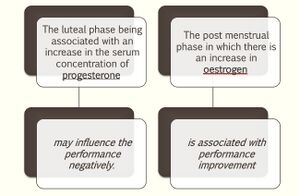Menstrual Cycle and Sports
Original Editor - Sultan Eylem Demirhan
Top Contributors - Sultan Eylem Demirhan
Introduction[edit | edit source]
Researchers and athletes consider that the menstrual cycle has an impact on the performance of athletes. That's why research in this field is increasing. However, results are still inconsistent as to whether significant changes of athletes' performance during the menstrual cycle are due to physiological variation (fluctuations of sex hormones). Tracking athletes' menstrual cycles and symptoms can be an important consideration for optimizing performance and maintaining the health of female athletes.[1]
Aspects of Performance[edit | edit source]
- STRENGTH
Because of their neuroexcitatory and inhibitory effects, estrogen and progesterone have a positive and negative relationship with force production. Estrogen has a neuroexcitatory effect, while progesterone inhibits cortical excitability.[2]
Acute increases in testosterone can enhance physical performance via improved neural activation
- RAPID FORCE PRODUCTION
The Menstrual Cycle phases can also have a notable effect on rapid force generation. Muscle activation, particularly initial motor unit firing rate, is the main determinant of rapid force generation required to perform explosive movements.[3]
How to detect Menstrual Cycle Phases[edit | edit source]
- Calender-based counting method
- Urinary LH (Luteinising Hormone) test: To determine the phase of Ovulation
- Blood tests to measure serum levels of estrogen and progesterone[1]
How to monitor athletes' cycle[edit | edit source]
In professional sports, routine MC phase monitoring is being used more and more frequently. The United States' Women's National Soccer and Swimming Teams , as well as Chelsea Football Club, have lately started employing a commercial smartphone app to track athletes' menstrual cycle phases. There is commercial smartphone apps to record when menstruation and various menstrual symptoms (such as menstrual pain or fatigue etc.) occur.[3]
Resources[edit | edit source]
- bulleted list
- x
or
- numbered list
- x
References[edit | edit source]
- ↑ 1.0 1.1 1. Janse DE Jonge X, Thompson B, Han A. Methodological recommendations for menstrual cycle research in sports and exercise. Med Sci Sports Exerc. 2019;51(12):2610–7.
- ↑ 1. Lowe DA, Baltgalvis KA, Greising SM. Mechanisms behind estrogens’ beneficial effect on muscle strength in females. Exercise and sport sciences reviews. 2010;38.
- ↑ 3.0 3.1 Carmichael MA, Thomson RL, Moran LJ, Wycherley TP. The impact of menstrual cycle phase on athletes’ performance: A narrative review. Int J Environ Res Public Health. 202;18(4):1667.







